Evaluation Method of Heavy-Ion-Induced Single-Event Upset in 3D-Stacked SRAMs
Abstract
1. Introduction
2. Experimental and Monte Carlo Simulation Details
2.1. Devices under Test (DUT) and Heavy-Ion Experimental Data
2.2. 3D Models of Bulk Silicon and SOI SRAM and the Numerical Simulation Details
3. Monte Carlo Simulation of 3D-Stacked Structure Devices
3.1. Results and Discussion of Monte Carlo Simulation for 3D-Stacked SRAMs
3.1.1. Simulation Results of Each Tier’s CS under Different Heavy-Ion Energy Conditions
3.1.2. Numerical Results Comparing the CS Per Bit under Different Heavy-Ion Energies
3.2. Critical Range of Heavy Ions to Evaluate SEE CS of 3D Devices
4. On-Orbit SEU Rate Prediction Methodology Based on Accelerator Test Experimental Data
4.1. Discussion of the SEE Test Standards of 3D Vertically Stacked Device
4.2. Verification of the SEE Test Standards of 3D Vertically Stacked Device
5. Conclusions
Author Contributions
Funding
Acknowledgments
Conflicts of Interest
References
- Topol, A.W.; Tulipe, D.C.L.; Shi, L.; Frank, D.J.; Bernstein, K.; Steen, S.E.; Kumar, A.; Singco, G.U.; Young, A.M.; Guarini, K.W.; et al. Three-dimensional integrated circuits. IBM J. Res. Dev. 2006, 50, 491–506. [Google Scholar] [CrossRef]
- Patti, R.S. Three-Dimensional Integrated Circuits and the Future of System-on-Chip Designs. Proc. IEEE 2006, 94, 1214–1224. [Google Scholar] [CrossRef]
- Koyanagi, M. Recent progress in 3D integration technology. IEICE Electron. Express 2015, 12, 20152001. [Google Scholar] [CrossRef]
- Gouker, P.M.; Wyatt, P.W.; Yost, D.-R.; Chen, C.K.; Knecht, J.M.; Chen, C.L.; Keast, C.L. Radiation Effects in MIT Lincoln Lab 3DIC Technology. In Proceedings of the IEEE International SOI Conference, Foster City, CA, USA, 5–8 October 2009; Volume 1, pp. 1–2. [Google Scholar] [CrossRef]
- Re, V.; Gaioni, L.; Manazza, A.; Manghisoni, M.; Ratti, L.; Traversi, G. Radiation Tolerance of Devices and Circuits in a 3D Technology Based on the Vertical Integration of Two 130-nm CMOS Layers. IEEE Trans. Nucl. Sci. 2013, 60, 4526–4532. [Google Scholar] [CrossRef]
- Zeng, Q.; Chen, J.; Jin, Y. Effect of Radiation on Reliability of Through-Silicon via for 3-D Packaging Systems. IEEE Trans. Device Mater. Reliab. 2017, 17, 708–712. [Google Scholar] [CrossRef]
- Gouker, P.M.; Tyrrell, B.; D’Onofrio, R.; Wyatt, P.; Soares, T.; Hu, W.; Chen, C.; Schwank, J.R.; Shaneyfelt, M.R.; Blackmore, E.W.; et al. Radiation Effects in 3D Integrated SOI SRAM Circuits. IEEE Trans. Nucl. Sci. 2011, 58, 2845–2854. [Google Scholar] [CrossRef]
- Gouker, P.M.; Tyrrell, B.; Renzi, M.; Chen, C.; Wyatt, P.; Ahlbin, J.R.; Weeden-Wright, S.; Atkinson, N.M.; Gaspard, N.J.; Bhuva, B.L.; et al. SET Characterization in Logic Circuits Fabricated in a 3DIC Technology. IEEE Trans. Nucl. Sci. 2011, 58, 2555–2562. [Google Scholar] [CrossRef]
- Uznanski, S.; Alia, R.G.; Blackmore, E.; Brugger, M.; Gaillard, R.; Mekki, J.; Todd, B.; Trinczek, M.; Villanueva, A.V. The Effect of Proton Energy on SEU Cross Section of a 16 Mbit TFT PMOS SRAM with DRAM Capacitors. IEEE Trans. Nucl. Sci. 2014, 61, 3074–3079. [Google Scholar] [CrossRef]
- Gupta, V.; Bosser, A.; Tsiligiannis, G.; Rousselet, M.; Mohammadzadeh, A.; Javanainen, A.; Virtanen, A.; Puchner, H.; Saigné, F.; Wrobel, F.; et al. SEE on Different Layers of Stacked-SRAMs. IEEE Trans. Nucl. Sci. 2015, 62, 2673–2678. [Google Scholar] [CrossRef]
- Cao, X.-B.; Xiao, L.-Y.; Huo, M.-X.; Wang, T.-Q.; Liu, S.-S.; Qi, C.-H.; Li, A.-L.; Wang, J.-X. Heavy ion-induced single event upset sensitivity evaluation of 3D integrated static random access memory. Nucl. Sci. Tech. 2018, 29, 31. [Google Scholar] [CrossRef]
- ASTM F1192-90: Standard Guide for the Measurement of Single Event Phenomena (SEP) Induced by Heavy Ion Irradiation of Semiconductor Devices; ASTM International: West Conshohocken, PA, USA, 2006.
- ESA. ESA/SCC Basic Specification No. 25100: Single Event Effects Test Method and Guidelines; ESA: Noordwijk, The Netherlands, 2014. [Google Scholar]
- Warren, K.M.; Weller, R.A.; Mendenhall, M.H.; Reed, R.A.; Ball, D.R.; Howe, C.L.; Olson, B.D.; Alles, M.L.; Massengill, L.W.; Schrimpf, R.D.; et al. The Contribution of Nuclear Reactions to Heavy Ion Single Event Upset Cross-Section Measurements in a High-Density SEU Hardened SRAM. IEEE Trans. Nucl. Sci. 2005, 52, 2125–2131. [Google Scholar] [CrossRef]
- Reed, R.A.; Weller, R.A.; Mendenhall, M.H.; Lauenstein, J.-M.; Warren, K.M.; Pellish, J.A.; Schrimpf, R.D.; Sierawski, B.D.; Massengill, L.W.; Dodd, P.E.; et al. Impact of Ion Energy and Species on Single Event Effects Analysis. IEEE Trans. Nucl. Sci. 2007, 54, 2312–2321. [Google Scholar] [CrossRef]
- Dodd, P.E.; Schwank, J.R.; Shaneyfelt, M.R.; Felix, J.A.; Paillet, P.; Ferlet-Cavrois, V.; Baggio, J.; Reed, R.A.; Warren, K.M.; Weller, R.A.; et al. Impact of Heavy Ion Energy and Nuclear Interactions on Single-Event Upset and Latchup in Integrated Circuits. IEEE Trans. Nucl. Sci. 2007, 54, 2303–2311. [Google Scholar] [CrossRef]
- Tylka, A.J., Jr.; Adams, J.H.; Boberg, P.R.; Brownstein, B.; Dietrich, W.F.; Flueckiger, E.O.; Petersen, E.L.; Shea, M.A.; Smart, D.F.; Smith, E.C. CREME96: A Revision of the Cosmic Ray Effects on Micro-Electronics Code. IEEE Trans. Nucl. Sci. 1997, 44, 2150–2160. [Google Scholar] [CrossRef]
- Weller, R.A.; Mendenhall, M.H.; Reed, R.A.; Schrimpf, R.D.; Warren, K.M.; Sierawski, B.D.; Massengill, L.W. Monte Carlo Simulation of Single Event Effects. IEEE Trans. Nucl. Sci. 2010, 57, 1726–1746. [Google Scholar] [CrossRef]
- Mendenhall, M.H.; Weller, R.A. A probability-conserving cross-section biasing mechanism for variance reduction in Monte Carlo particle transport calculations. Nucl. Instrum. Methods Phys. Res. Sect. Accel. Spectrom. Detect. Assoc. Equip. 2012, 667, 38–43. [Google Scholar] [CrossRef]
- Ziegler, J.F.; Ziegler, M.D.; Biersack, J.P. SRIM—The stopping and range of ions in matter. Nucl. Instrum. Methods Phys. Res. Sect. B Beam. Interact. Mater. At. 2010, 268, 1818–1823. [Google Scholar] [CrossRef]
- Xapsos, M. A Brief History of Space Climatology: From the Big Bang to the Present. IEEE Trans. Nucl. Sci. 2018, 66, 17–37. [Google Scholar] [CrossRef]
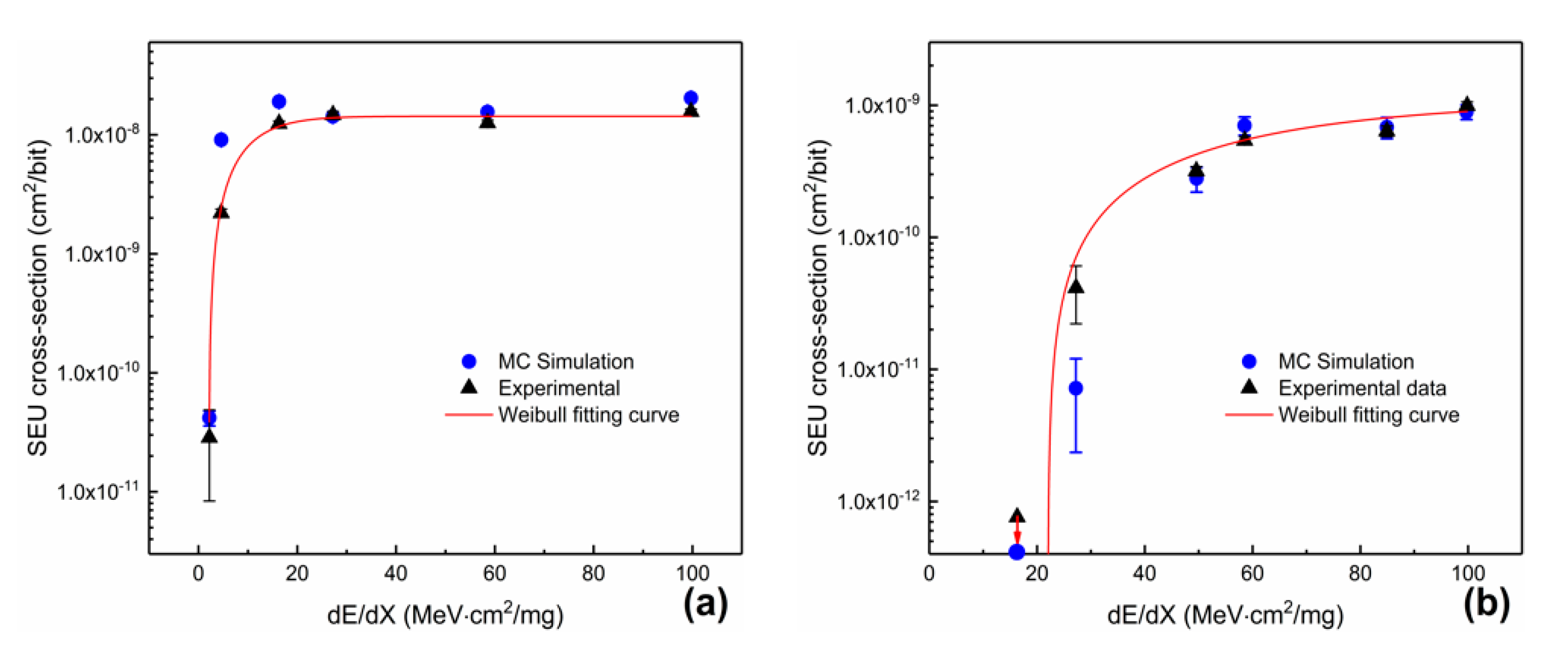
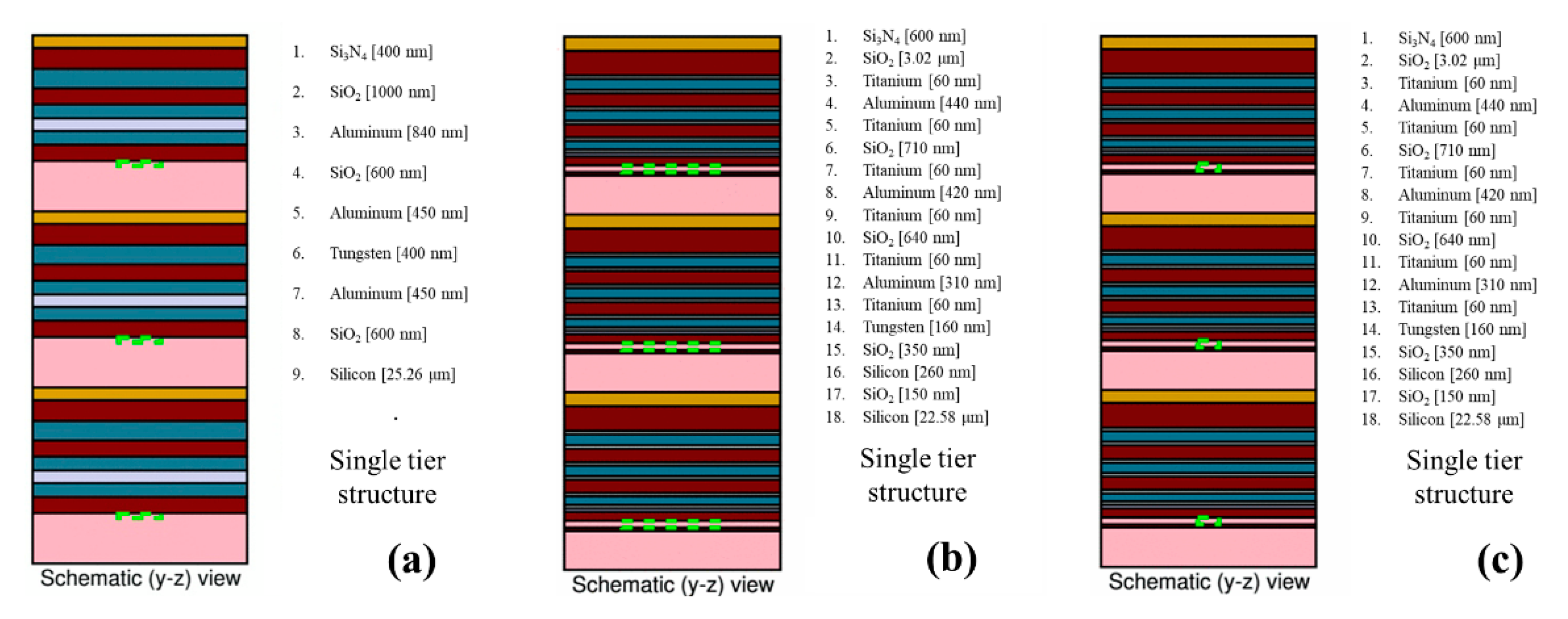
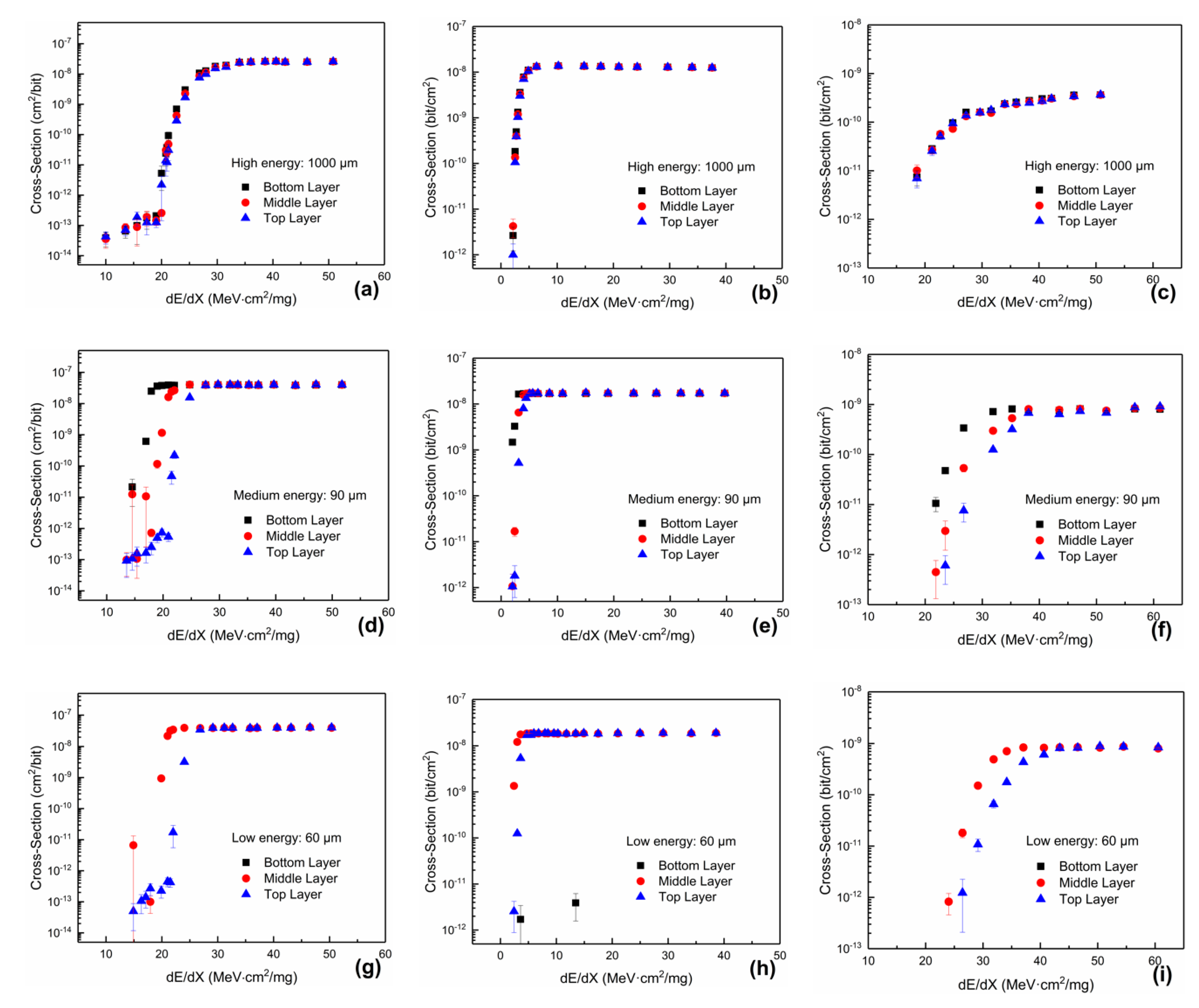



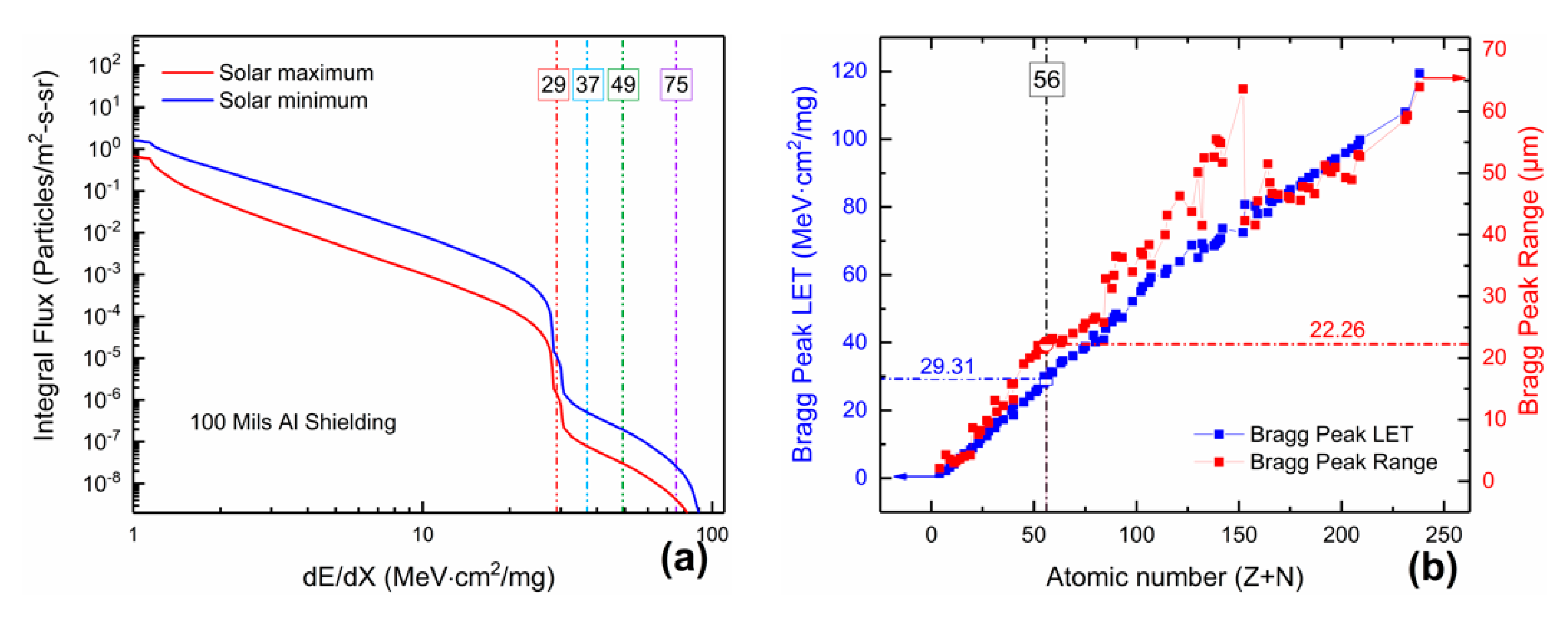

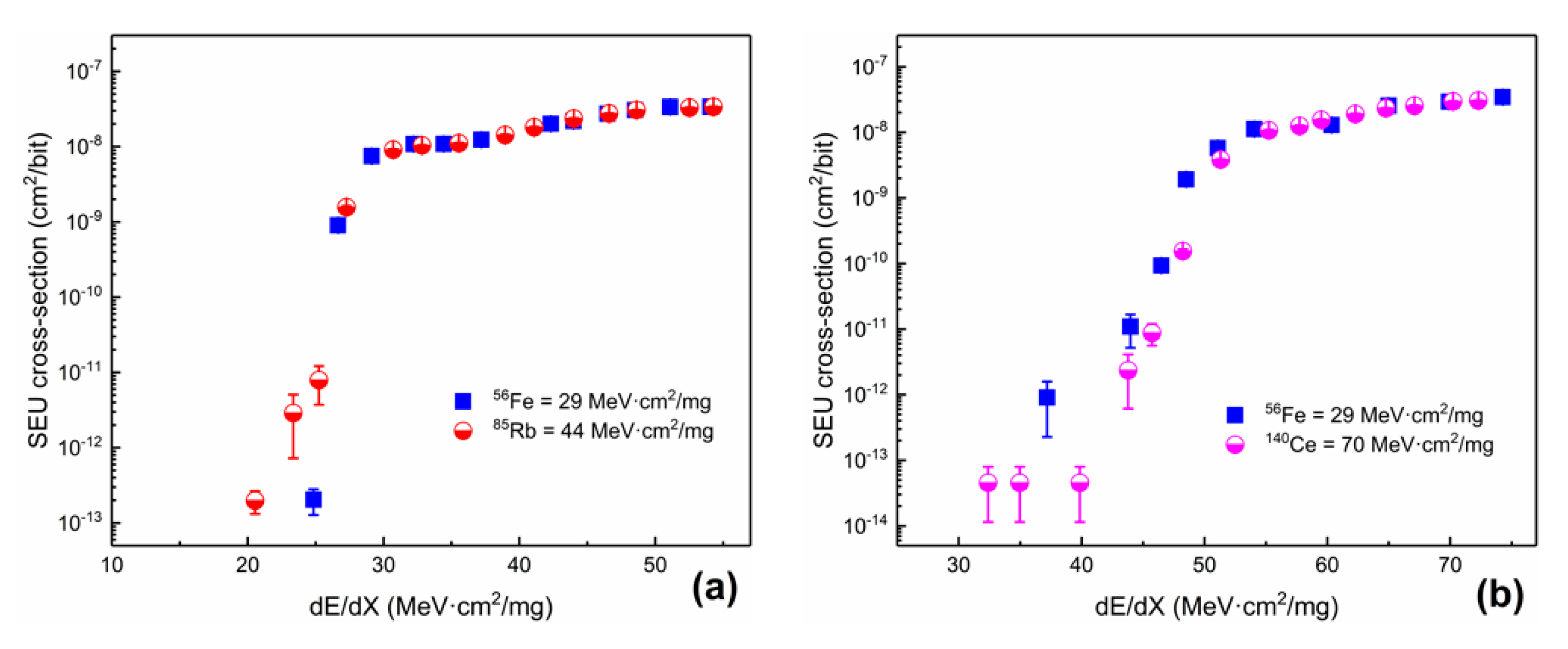

| Threshold LETs (MeV·cm2/mg) | Ttotal < Rmin | Rmin ≤ Ttotal ≤ Rmax 56Fe Ions Bragg Peak | Ttotal > Rmax | |
|---|---|---|---|---|
| Rmin (μm) | Rmax (μm) | |||
| Lth ≤ 30 | – | 0 | 3878 | σT = n × σS |
| 30 < Lth ≤ 37 | 74Ge ions Bragg peak | 8 | 2228 | σT = n × σS |
| 37 < Lth ≤ 49 | 102Ru ions Bragg peak | 44 | 1078 | σT = n × σS |
| 49 < Lth ≤ 75 | 164Dy ions Bragg peak | 190 | 358 | σT = n × σS |
| Threshold LETs (MeV·cm2/mg) | Calibration Ions | Bragg Peak | Critical Range (μm) | SEUR (Upsets/day/bit) | ||||
|---|---|---|---|---|---|---|---|---|
| LET (MeV·cm2/mg) | Range (μm) | Top | Medium | Bottom | Average | |||
| 45 | 56Fe | 29.3 | 22 | 210 | 1.43 × 10−10 | 3.72 × 10−11 | 1.36 × 10−11 | 6.18 × 10−11 |
| 85Rb | 44.2 | 33 | 220 | 1.26 × 10−10 | 3.46 × 10−11 | 1.44 × 10−11 | 5.86 × 10−11 | |
| 70 | 56Fe | 29.3 | 22 | 210 | 9.10 × 10−12 | 1.07 × 10−12 | 2.43 × 10−13 | 3.16 × 10−12 |
| 140Ce | 70.1 | 55 | 243 | 6.45 × 10−12 | 1.06 × 10−12 | 1.70 × 10−13 | 2.57 × 10−12 | |
| Ion Species | Surface Energy (MeV/u) | Surface LET (MeV·cm2/mg) | Range (μm) |
|---|---|---|---|
| 209Bi | 28.0 | 67.3 | 318 |
| 27.4 | 67.9 | 310 | |
| 26.3 | 68.9 | 295 |
© 2020 by the authors. Licensee MDPI, Basel, Switzerland. This article is an open access article distributed under the terms and conditions of the Creative Commons Attribution (CC BY) license (http://creativecommons.org/licenses/by/4.0/).
Share and Cite
Zhao, P.; Liu, T.; Cai, C.; He, Z.; Li, D.; Liu, J. Evaluation Method of Heavy-Ion-Induced Single-Event Upset in 3D-Stacked SRAMs. Electronics 2020, 9, 1230. https://doi.org/10.3390/electronics9081230
Zhao P, Liu T, Cai C, He Z, Li D, Liu J. Evaluation Method of Heavy-Ion-Induced Single-Event Upset in 3D-Stacked SRAMs. Electronics. 2020; 9(8):1230. https://doi.org/10.3390/electronics9081230
Chicago/Turabian StyleZhao, Peixiong, Tianqi Liu, Chang Cai, Ze He, Dongqing Li, and Jie Liu. 2020. "Evaluation Method of Heavy-Ion-Induced Single-Event Upset in 3D-Stacked SRAMs" Electronics 9, no. 8: 1230. https://doi.org/10.3390/electronics9081230
APA StyleZhao, P., Liu, T., Cai, C., He, Z., Li, D., & Liu, J. (2020). Evaluation Method of Heavy-Ion-Induced Single-Event Upset in 3D-Stacked SRAMs. Electronics, 9(8), 1230. https://doi.org/10.3390/electronics9081230






